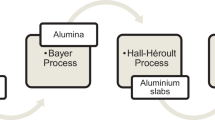Abstract
The iron and steel industry is the second largest user of energy in the world industrial sector and is currently highly dependent on fossil fuels and electricity. Substituting fossil fuels with renewable energy in the iron and steel industry would make an important contribution to the efforts to reduce emissions of CO2. However, different approaches to assessing CO2 emissions from biomass and electricity use generate different results when evaluating how fuel substitution would affect global CO2 emissions. This study analyses the effects on global CO2 emissions when substituting liquefied petroleum gas with synthetic natural gas, produced through gasification of wood fuel, as a fuel in reheating furnaces at a scrap-based steel plant. The study shows that the choice of system perspective has a large impact on the results. When wood fuel is considered available for all potential users, a fuel switch would result in reduced global CO2 emissions. However, applying a perspective where wood fuel is seen as a limited resource and alternative use of wood fuel is considered, a fuel switch could in some cases result in increased global CO2 emissions. As an example, in one of the scenarios studied, a fuel switch would reduce global CO2 emissions by 52 ktonnes/year if wood fuel is considered available for all potential users, while seeing wood fuel as a limited resource implies, in the same scenario, increased CO2 emissions by 70 ktonnes/year. The choice of method for assessing electricity use also affects the results.


Similar content being viewed by others
Notes
Composition of heat production: 86 % bio-HOB, 4 % coal-HOB, 2 % natural gas-HOB, 4 % oil-HOB, 4 % other renewables.
Composition of heat production: 55 % bio-CHP, 3 % coal-CHP, 28 % bio-HOB, 4 % heat pumps, 6 % natural gas-CHP, 1 % coal-HOB,1 % natural gas-HOB, 1 % oil-HOB, 1 % other renewables.
References
Åbyhammar, T., & Östergård, K. (2001). Mapping the energy use and energy efficiency potential at Sandvik Steel AB, Sandviken [Kartläggning av energianvändning och energieffektiviseringspotential vid Sandvik Steel AB, Sandviken]. Vattenfall AB.
AISI. (2015). American iron and steel institute. www.steel.org/en/Making%20Steel/Research%20and%20Development.aspx. Accessed 6 May 2015.
Axelsson, E., & Harvey, S. (2010). Scenarios for assessing profitability and carbon balances of energy investments in industry—pathways to sustainable European energy systems. Gothenburg: AGS, The Alliance for Global Sustainability.
Axelsson, E., Harvey, S., & Berntsson, T. (2009). A tool for creating energy market scenarios for evaluation of investments in energy intensive industry. Energy, 34(12), 2069–2074.
Basu, P. (2010). Chapter 6—design of biomass gasifiers. In P. Basu (Ed.), Biomass gasification and pyrolysis: practical design and Theory. Academic Press.
Broekhoff, D., McCormick, M., Murtishaw, S., Diamant, A., Cowan, J., Platts, J., et al. (2007). The greenhouse gas protocol—guidelines for quantifying GHG reductions from grid-connected electricity projects. In D. Broekhoff (Ed.). World Resources Institute.
Chalmers Energy Centre. (2007). Biokombi Rya biomass gasification project—final report [Biokombi Rya—Slutrapport från ingående delprojekt]. Gothenburg: Chalmers University of Technology [in Swedish].
Cherubini, F. (2010). GHG balances of bioenergy systems—overview of key steps in the production chain and methodological concerns. Renewable Energy, 35(7), 1565–1573.
Dotzauer, E. (2010). Greenhouse gas emissions from power generation and consumption in a Nordic perspective. Energy Policy, 38(2), 701–704.
EEE. (2016). Biomass power plant Güssing—fluidised steam gasification (thermal gasification). www.eee-info.net/cms/netautor/napro4/appl/na_professional/parse.php?mlay_id=2500&mdoc_id=1000558. Accessed 12 Jan 2016.
European Environment Agency. (2009). CO2 (g) per kWh (electricity only).
Gode, J., Martinsson, F., Hagberg, L., Öman, A., Höglund, J., & Palm, D. (2011). Miljöfaktaboken 2011—estimated emission factors for fuels, electricity, heat and transport in Sweden Report No. 1183, Värmeforsk (In Swedish).
Göteborg Energi. (2016). GoBiGas. gobigas.goteborgenergi.se/English_version/Start. Accessed 12 Jan 2016.
Gustavsson, L., Haus, S., Ortiz, C. A., Sathre, R., & Truong, N. L. (2015). Climate effects of bioenergy from forest residues in comparison to fossil energy. Applied Energy, 138, 36–50.
Hasegawa, F., Yokoyama, S., & Imou, K. (2010). Methanol or ethanol produced from woody biomass: which is more advantageous? Bioresource Technology, 101(1, Supplement), S109–S111.
Hawkes, A. D. (2010). Estimating marginal CO2 emissions rates for national electricity systems. Energy Policy, 38(10), 5977–5987.
Hawkes, A. D. (2014). Long-run marginal CO2 emissions factors in national electricity systems. Applied Energy, 125, 197–205.
IEA. (2013a). Energy technology perspectives: scenarios & strategies to 2050, fact sheet industry. www.iea.org/publications/freepublications/publication/industry.pdf. Accessed 18 Nov 2013.
IEA. (2013b). World energy outlook 2013.
Jäppinen, E., Korpinen, O.-J., Laitila, J., & Ranta, T. (2014). Greenhouse gas emissions of forest bioenergy supply and utilization in Finland. Renewable and Sustainable Energy Reviews, 29, 369–382.
JISF. (2011). Japan iron and steel federation. www.jisf.or.jp/course50/outline/index_en.html Accessed 6 May 2015.
Levihn, F. (2014). CO2 emissions accounting: whether, how, and when different allocation methods should be used. Energy, 68, 811–818.
Lindeström, L., Löfblad, G., & Löfblad, E. (2008). Environmental impact assessment report with regard to increased production at SSAB Luleå [Miljökonsekvensbeskrivning gällande ökad produktion vid SSAB Luleå]. Svensk MKB and Profu. (In Swedish).
POSCO. (2015). Climate change policy. www.posco.co.kr/homepage/docs/eng2/html/sustain/environ/s91d1050150c.jsp. Accessed 6 May 2015.
Swedish Energy Agency. (2014). Energy in Sweden—facts and figures.
ULCOS. (2015). www.ulcos.org. Accessed 6 May 2015.
World Steel Association. (2014). Crude steel production. www.worldsteel.org/statistics/crude-steel-production.html. Accessed 7 Feb 2014.
Acknowledgments
The author would like to thank the personnel at the steel plant for valuable information. The work has been carried out under the auspices of the Energy Systems programme which is financed by the Swedish Energy Agency. The work was co-financed by Göranssonska Fonden.
Author information
Authors and Affiliations
Corresponding author
Rights and permissions
About this article
Cite this article
Johansson, M.T. Effects on global CO2 emissions when substituting LPG with bio-SNG as fuel in steel industry reheating furnaces—the impact of different perspectives on CO2 assessment. Energy Efficiency 9, 1437–1445 (2016). https://doi.org/10.1007/s12053-016-9432-0
Received:
Accepted:
Published:
Issue Date:
DOI: https://doi.org/10.1007/s12053-016-9432-0




